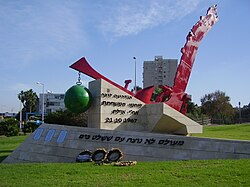Second World War
After commissioning and working up at Scapa Flow, Zealous joined the 2nd Destroyer Flotilla of the Home Fleet. [12] On 20 November 1944, [12] as part of an offensive against German shipping (and in particular ships carrying Iron ore) passing through Norwegian coastal waters, [13] Zealous, together with the destroyers Onslaught, Scorpion and Scourge and the cruiser Diadem, escorted the escort carriers Premier and Pursuer as the carriers' aircraft laid mines off Haugesund. [14] On 7–14 December 1944, Zealous took part in Operation Urbane, another anti-shipping operation off the coast of Norway involving the carriers Implacable, Premier and Trumpeter during Arctic convoy RA 62. The carriers' aircraft laid mines and sank two merchant ships. Part of the force, including Zealous, was spotted by German reconnaissance aircraft on 14 December. In response, the Germans launched a 30-aircraft strong torpedo-bomber strike, but it failed to find the British force. [15]
On 6 February 1945, Zealous joined the close escort of Arctic Convoy JW 64. The Germans deployed 8 U-boats near Bear Island with a further 4 U-boats off the Kola Inlet, and carried out two large air attacks on the convoy, but only one escort, the corvette Denbigh Castle was lost, torpedoed by the German submarine U-992, with no merchant ships hit. [16] [17] Zealous, along with the destroyers HMS Zambesi, HMS Zest, and HMCS Sioux were detached from the convoy on 14 February in order to rescue the population of Sørøya island, Norway, [16] 60 miles (97 km) behind enemy lines. The four destroyers rescued 525 Norwegians, who had been hiding from German patrols in caves on the snow-covered mountains for three months. The Norwegians were safely evacuated via the return RA 64 to the British port of Gourock. [18] [19] On 16 February, Zealous took part in an operation by British and Soviet ships to drive away U-boats that were waiting outside the Kola Inlet. The convoy sailed on 17 February, with Zealous again part of the close escort. Two escorts (the sloop Lark and the corvette Bluebell) and two merchant ships (Thomas Scott and Henry Bacon) were lost, with one U-boat (U-425) also sunk. [20] [21]
On 5 April 1945 Zealous was involved in an attack on a convoy entering the Jøssingfjord on the coast of Norway. One merchant ship was sunk and two were damaged. [22] On 18 April 1945, Zealous joined the escort of Arctic Convoy JW 66, which arrived at the Kola Inlet on 25 April. [23] [24] On 29 April Zealous set out as part of the escort of the return convoy RA 66, leaving the convoy on 5 May. [25] [26] The war in Europe ended on VE Day on 8 May 1945, and on 9 May, Zealous was part of a force of two cruisers (Birmingham and Dido) and four destroyers (Zealous, Zephyr, Zest and Zodiac), that helped to liberate Copenhagen, with the force taking the surrender of the German naval forces based there. Zealous and Zodiac then moved on to occupation duties at Kiel. [27]



